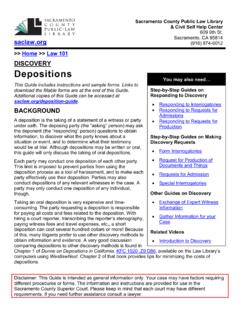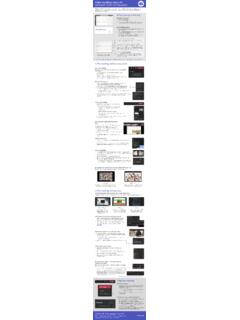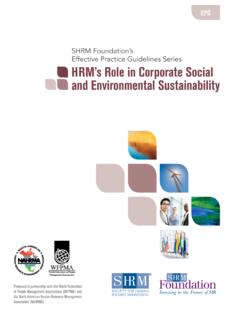Transcription of Accessible Information Standard Different types of ...
1 Accessible Information Standard Different types of Accessible Information and communication support and who may need them Support for people who are blind or have some visual loss A person who is blind or has some visual loss may need Information which is usually written down or provided in Standard print in an alternative format such as: audio, on CD or as an MP3 file, braille, email or large print. People who are blind, deafblind or have some visual loss may require Information to be sent or shared with them electronically via email instead of in a written or printed format. The use of email enables the recipient to use their own assistive technology or software, for example a screen reader' which converts text to speech.
2 Depending on the software or assistive technology used, a person who is blind or has some visual loss may require Information sent to them electronically (emailed) in one or more specific formats such as plain text (with or without attachments), HTML, and with attachments in Word or PDF format. A person who is blind or has some visual loss may need visual Information in the form of an audible alert. For example, many blind people cannot read their name on a screen or notice and so will need to be told or guided to the appropriate room and /. or seat. Support for people who are d/Deaf or have some hearing loss A person who is d/Deaf or has some hearing loss may require support from a communication professional, including a British Sign Language (BSL) interpreter, BSL interpreter who uses Sign-Supported English, Lipspeaker, Notetaker, or speech-to-text reporter (STTR).
3 A person who is d/Deaf may also need Information which is usually provided in Standard print in BSL video format. A person who is d/Deaf or has some hearing loss may also need support to communicate because they: Lipread in which case the speaker should clearly address the person and face them whilst speaking, avoid touching or covering their mouth, and ensure conversations are held in well-lit areas; and / or Publications Gateway Reference 05338. May 2016. For more Information , please contact Use a hearing aid in which case care should be taken to speak clearly and a loop system may support conversation in reception or waiting areas. It should be noted that the ability of d/Deaf people to read and understand written English varies considerably and it should not be assumed that having a conversation via written notes is an appropriate way of holding a dialogue.
4 Similarly, it should not be assumed that because someone is wearing one or more hearing aids they no longer need any support to communicate, they may, for instance, be supporting their hearing via lipreading. The person's communication needs must be established with them in the first instance. A person who is d/Deaf may need verbal or audio Information in the form of visual alert. For example, many d/Deaf people cannot hear their name called in a waiting area. Support for people who are deafblind types of communication support which may be needed by a person who is deafblind are as follows. It should be noted that many deafblind people will use a combination of Different mechanisms to support communication.
5 A deafblind person may require support from a communication professional: British Sign Language (BSL) interpreter, who may need to be particularly skilled to work with deafblind people who need BSL adapting in the following ways: - BSL interpreter - hands-on signing - BSL interpreter - visual frame signing Deafblind manual interpreter Speech-to-text-reporter (STTR). A deafblind person may receive individual support from an identified professional to support them in communicating, such as a Deafblind communicator- guide or Deafblind intervenor. If so, it would be expected that this person would accompany the deafblind person. A deafblind person may need written Information in an alternative format, such as braille or via email.
6 Publications Gateway Reference 05338. May 2016. For more Information , please contact A deafblind person may also need support to communicate using a communication tool or aid. They may also rely on the use of Tadoma to communicate or use a Voice Output Communication Aid (VOCA). A deafblind person may also use non-verbal communication including gestures, pointing or eye-pointing. Support for people with a learning disability A person who has a learning disability may need Information which is usually provided in Standard English provided in an alternative format such as easy read' or explained using Makaton. A person with a learning disability: - may require support from a communication professional at their appointment, for example an advocate.
7 - may also need support to communicate using a communication tool or aid. They may also have a communication passport'. - may also use non-verbal communication including gestures, pointing or eye- pointing. It should be noted that the level of a person's learning disability will have a significant impact on their ability to communicate and therefore level of support needed. People with a mild or moderate learning disability may be living independently and need Information in easy read' format and verbal Information explained more slowly and simply. A person with a more severe or profound learning disability is likely to be supported by one or more carers and will need additional support to communicate, including using a communication tool or aid.
8 People with a more severe learning disability are more likely to communicate in non-verbal and non-traditional ways. The Accessible Information Standard is concerned with ensuring that people with Information and / or communication needs relating to or caused by a disability, impairment or sensory loss have those needs met by organisations providing health and / or adult social care. In the vast majority of cases, such needs can be met using Standard ' or standardised' alternative formats (such as braille), mainstream' contact methods (such as email), standardised' communication methods (such as British Sign Language) and / or other generic' adjustments (for example facing someone to enable them to lipread).
9 However, a minority of people with Information and / or communication needs relating to a disability, impairment or sensory loss have multiple and / or complex needs, meaning that they require bespoke tools and / or communication support to Publications Gateway Reference 05338. May 2016. For more Information , please contact enable or communication. Individuals with multiple and / or complex needs are more likely to use alternative and / or non-verbal communication methods, and may use a highly personal communication system, for example particular gestures or eye- pointing, which may require interpretation from someone close to them who understands them well. In these instances, services should make use of the communication devices or tools usually used by the individual, and work with their carer(s), family members, support workers and others who know them well to identify and use communication approaches which maximise the involvement and inclusion of the individual.
10 Services may find documentation of the needs of individuals with bespoke or highly personalised Information and / or communication needs challenging, and use of a communication passport' or similar document to support standardised / coded recording would be advisable Advocate: a person who supports someone who may otherwise find it difficult to communicate or to express their point of view. Advocates can support people to make choices, ask questions and to say what they think. Accessible Information : Information which is able to be read or received and understood by the individual or group for which it is intended. Alternative format: Information provided in an alternative to Standard printed or handwritten English, for example large print, braille or email.














